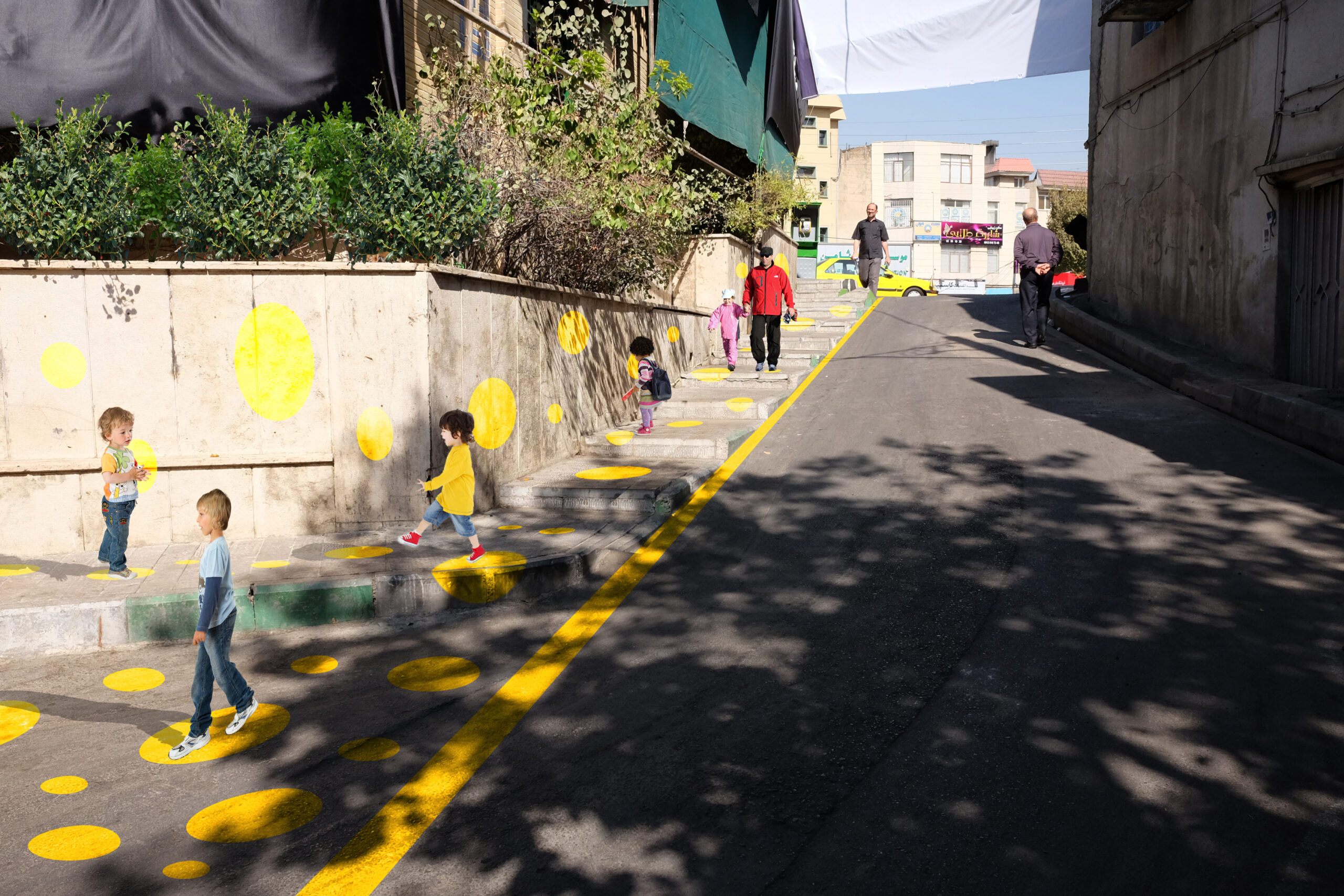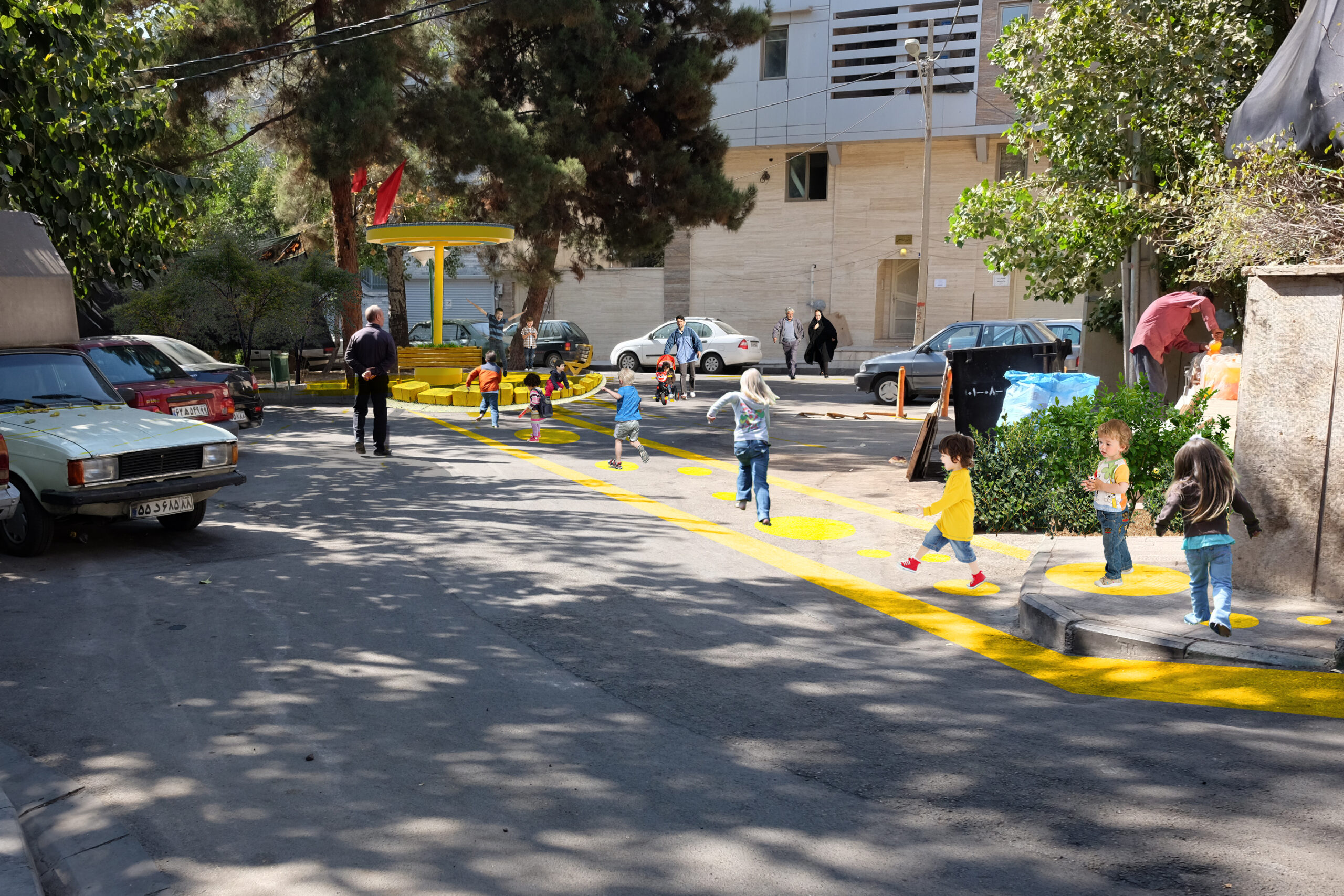A Proposal For
Child-Friendly City of Tehran
October 2016
The Beginning
We began our proposal for a child-friendly Tehran by surveying CFC-related content from the United Nations and other relevant international bodies. From the set of criteria mentioned in these documents, we briefly selected the following criteria as the main requirements of our child-friendly city:
![]() Development of pedestrian life, ensuring the safety of pedestrians in the city.
Development of pedestrian life, ensuring the safety of pedestrians in the city.
![]() Development of collective space, providing play and learning environment.
Development of collective space, providing play and learning environment.
![]() Revitalizing the natural landscape.
Revitalizing the natural landscape.
![]() Enact laws to protect children’s rights.
Enact laws to protect children’s rights.
![]() Involve children in urban planning.
Involve children in urban planning.
From the above, except for the enactment of laws that are the responsibility of legislators and law enforcement, other things can be considered in the plan. Involving children in city affairs and urban planning can be seen as a gateway to a child-friendly city. So we decided to go directly to the children to gather information.
Collage workshop “Tehran-making”
October 7, 2016, Boomerang Academy
On Iranian Children’s Day, a “Tehran-making” workshop was held with the participation of children aged 3 to 12 by group members at the Boomerang Academy. In this workshop, pre-prepared pieces were given to the children and they were asked to build their own Tehran. The pieces were selected in such a way that they could comprehensively reflect the concerns and aspirations of the children about the city. A collection of buildings in various scales (villas, apartments, towers), vehicles (cars, buses, bicycles), natural elements (mountains, trees, vegetation), play equipment, people of different ages, important symbols of Tehran (Milad Tower, Azadi Tower) and … were among the pieces that were given to children.
Children of different ages and conditions prepared and delivered their collages from Tehran. By putting together a total of 17 collages and their qualitative and statistical analysis, significant results were obtained. The summary of the analyses is as follows:
- Children have expressed their concern about commuting in the city by showing traffic congestion in collages.
- Children have shown their desire to play in the city by using play equipment in collages.
- Children have imagined themselves more at home because they do not feel belonging to the city and do not feel safe in it.
In addition to these three main results, children have paid attention to the natural geography of the city by placing a mountain on top of the collage and also use of the artificial heritages of the city (Milad and Azadi Tower) have been noticeable in most collages.

Commuting / Playing & Learning / Sense of Belonging
According to the analysis of the collages, responding to children’s concerns became the main challenge. One of the presuppositions for us was to provide a comprehensive plan without the need for special infrastructure. The only precondition for this plan is the rehabilitation and standardization of the city’s sidewalks so that it is safe and secure for children and their parents to cross. The following must be considered in the proposal:
- No need for infrastructure.
- Drag the child to the city with security.
- Increase the child’s sense of belonging to the city.
- Facilitate the child’s communication in the city.
- Provide a play and learning environment for the child.
- Provide parental supervision.
- Involve children and adolescents in the participatory decision-making process.
The idea of networks
To answer the above, we propose to define two networks that can, by increasing integration, take the city one step closer to being child-friendly. By defining two physical and virtual social networks, without the need for major infrastructure changes, it is possible to make a significant change in the sense of belonging of children to the city and by encouraging them to be in the city, provide opportunities for them to play and educate in the city. These two networks are:
 Physical network
Physical network
- Flexible urban nodes for children.
- Safe and optimized paths, connecting nodes.
 Virtual network
Virtual network
- Creating a virtual social network to connect children with the city
Idea Development
The physical network consists of two elements, node and path. In the neighborhood and city dimensions, these elements define continuous clusters that connect alleys and homes to flexible nodes for children. The paths are identified with graphics and colors, and the nodes are marked with the use of colors, graphics, and architectural elements. In this way, children on the street can follow the path of the nodes and see the signs and realize that they have reached their own corners in the city. Nodes should be flexible in terms of location, arrangement, and events, and should be programmed accordingly. They can be used for urban games, acquaintance with nature, education, etc. A virtual network is a website and application that connects the place-event and the stakeholders and influencers. This network is designed for children, teenagers and parents. In this program, the location and quality information of each node and all events that occur in this network are uploaded by users. It is possible to evaluate places and events, and teenagers can define new places and urban nodes by participating.
Node 

In small local parks, urban parks, local squares, and urban open spaces.
- Redefine the neighborhood for children.
- Provide play and learning facilities.
- Use of formal and graphic elements.
- Flexibility in layout and use.
- No need for special construction infrastructure.

Path 

In the main streets and alleys leading to the defined nodes.
- Provide safety for commuting.
- Use of graphic elements.
- Connecting nodes to each other and showing their location.
- Connecting schools and other children’s spaces with the city.

App 


On computers, tablets and smartphones.
- Database and management of the Physical network, with the possibility of socializing.
- Provide information on the nodes.
- Provide information on the paths and public transport to facilitate communication.
- Ability to create and manage urban events.
- Ability to define shared collective spaces by users.
- Ability to evaluate places and events.

Site Analysis
Although our proposal is applicable in all neighborhoods of the city and all the sites defined by the competition, we chose Chizar to test the idea on a neighborhood scale. Due to proper access to residential areas and the existence of urban open space in the south of Imamzadeh Square, this area was selected for the design.
Opportunities
- Historical background
- Neighborhood identity
- Natural potentials
- Existence of community center
Threats
- Too much building constructions
- Traffic congestion
- Lack of standard urban facilities
Nodes Design
For the nodes, an element had to be designed that could become a symbol for children. A Flexible element with no special infrastructure and the ability to induce a sense of security in children. The combination of these criteria led us to design a shelter whose walls are the city. This shelter can be considered as an umbrella in different dimensions and sizes in the corners of the city. Under this sign, many events can be experienced, from games to education, which will be formed with the participation of citizens.
- Security and shelter
- Flexibility in layout
- Scale variation
- No need for special infrastructure
- Simplicity
The use of color and its effect on children
We use color cues to define nodes and paths. These colors and signs can produce a visual identity for nodes and pathways, in addition, colors have psychological effects on children. Colors should be used as a tool to communicate with children because children love colors and react to them simply with their language. Colors can irritate children – especially those who are inattentive and unable to concentrate. With the help of colors, children learn to express emotions and show more creativity. Colors can help children who have difficulty expressing emotions and feelings. Different themes can be used for nodes and paths. For example, depending on the neighborhood or the seasons or the characteristics of each node, specific colors can be used.
Our Group Members
Ardalan Tayefeh, Nima Tabrizi, Maryam Badiei
Special thanks to Boomerang Academy, Bamdad BazrAfkan, and Dorsa Jalalian.
















